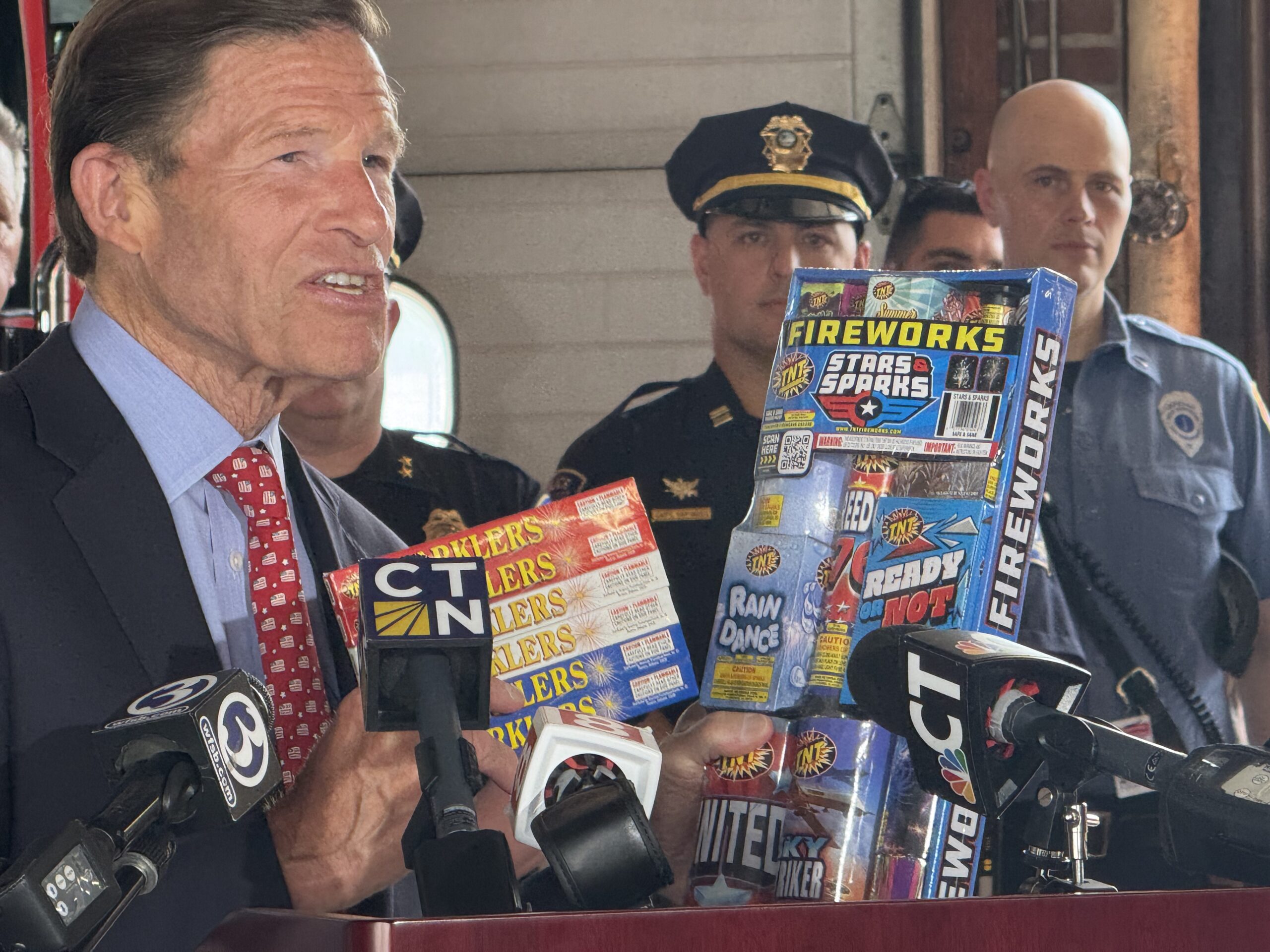West Hartford Fourth-Grader’s Essay Earns Him Rare Tour of Amazon Facility

Audio By Carbonatix
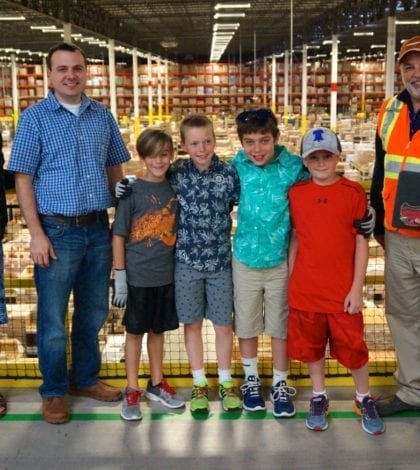
From left: QuEST teacher Kathy Hardesty, Amazon General Manager Jeff Laurendeau, Charlie Sink, Britt Housum, Evan Berey, Alexander Hyams, and John Parkos of Amazon after the tour. Photo credit: Ronni Newton
The essay written by West Hartford resident Britt Housum earned him a top Connecticut prize and a national award, but as an unexpected bonus he also got a tour of the Amazon Fulfillment Center in Windsor.
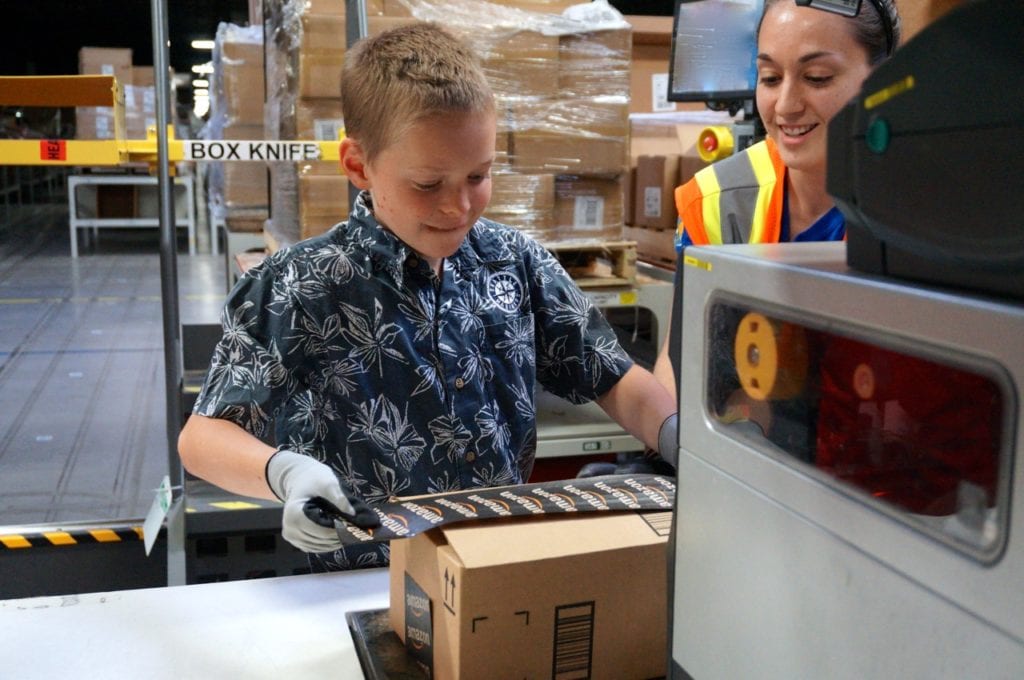
Britt Housum seals up a box he packed at the Amazon Fulfillment Center. Photo credit: Ronni Newton
By Ronni Newton
Britt Housum, a fourth-grader at West Hartford’s Norfeldt Elementary School, is a big fan of Amazon, and he’s also a whiz with numbers, a Math QuEST student, and a participant in the SIFMA (Securities Industry and Financial Markets Association) Foundation’s Stock Market Game. Those interests combined to earn Britt the privilege of getting a tour of the year-old Amazon Fulfillment Center in Windsor – a place few members of the public get to see.
Britt won first place for Connecticut in the elementary school division of the SIFMA Foundation’s Fall 2015 InvestWrite essay competition, and his essay – which was about Amazon and how it interacts with companies in other sectors – won ninth place nationally and the “InvestWrite Genius” title. The essay prompt was to “consider an investing scenario and make recommendations that incorporate short- and long-term financial goals.” Britt’s essay, reproduced in its entirety below, explored how things that he sees on his way to school have been impacted by investments and how Amazon’s success affects other companies, employment, and the community as a whole.
Britt said he thought to write his essay about Amazon because he uses it a lot, and its one of the stocks he “purchased” in the Stock Market Game. “It’s very quick and easy, and I don’t have to go anywhere,” Britt said. He said he spends gift cards he gets for special occasions on Amazon.com.
The essay was brought to the attention of the management of the Windsor fulfillment center, and Britt was invited for a tour on Wednesday afternoon.
“I read through your essay, and we pride ourselves on how we interact with the community,” General Manager Jeff Laurendeau told Britt before beginning the tour. Britt’s father, Jonathan Housum, QuEST teacher Kathy Hardesty, and Britt’s classmates Alexander Hyams, Evan Berey, and Charlie Sink were also invited for the behind-the-scenes tour.
First stop was the “learning center,” where new associates are schooled in Amazon procedures, including safety. There are approximately 800 associates in the Windsor Fulfillment Center, Laurendeau said.
The vastness of the facility – which measures more than 1 million square feet – was visible from the learning center. Boxes of items – toasters, TVs, coffeemakers, etc. – seemed to whiz about the floor on their own, but a closer look revealed that they were atop orange “robots.”
“Amazon Robotics is how we blend technology and associates,” Laurendeau explained. The Windsor fulfillment center uses approximately 1,000 robots, he said.
Amazon spokesperson Aaron Toso said that the floor of the fulfillment center is arranged in a “random stow” format which maximizes space, but the robots know where to find everything. The robots retrieve items from the floor and deliver them to pickers. “Technology tells them what box to use, and even automatically dispenses the right amount of tape,” Toso said.
“Robots let us better utilize the space, and we can have more items available for purchase,” said Toso.
Laurendeau showed Britt and his classmates where the products enter the fulfillment center, and the other side – where they are shipped out to customers packed in boxes. Conveyors transport the boxes directly into waiting trucks from a variety of transit carriers.
At this time of year the Windsor fulfillment center is moving about 500,000 units per week, but that number may jump to 1 million at peak times.
Unique to this building, Laurendeau pointed out, is a robotic recycling system that manages dumpsters full of corrugated cardboard so they can be crushed and transported to a recycling facility.
Before the tour ended, the students were given special hands-on opportunity to pack a few boxes. They built and taped the boxes, filled them with the proper products and packing material, and affixed the label. Britt was really excited that someone would be receiving a box full of coffee that he had packed.
At the very end of the tour, Britt received a major surprise when Laurendeau presented him with an Amazon Echo – a hands-free speaker that is voice-controlled and plays music, and provides information like sports scores and weather.
“It was a really cool experience,” Britt said after the tour. The visit fueled his interest in Amazon even more, and said he still has a lot of questions about the operation.
Hardesty was also fascinated with the tour, which augmented the learning experience for the students. “We always play the Stock Market Game,” she said, and she believes it provides students with important real world lessons. The essay contest is tied to the SIFMA Stock Market Game.
Hardesty said that over the years she has had a few Connecticut winners in the InvestWrite competition, but never a national winner.
“I love how it’s so giant. I really just want to work here,” said Britt.
Like what you see here? Click here to subscribe to We-Ha’s newsletter so you’ll always be in the know about what’s happening in West Hartford!
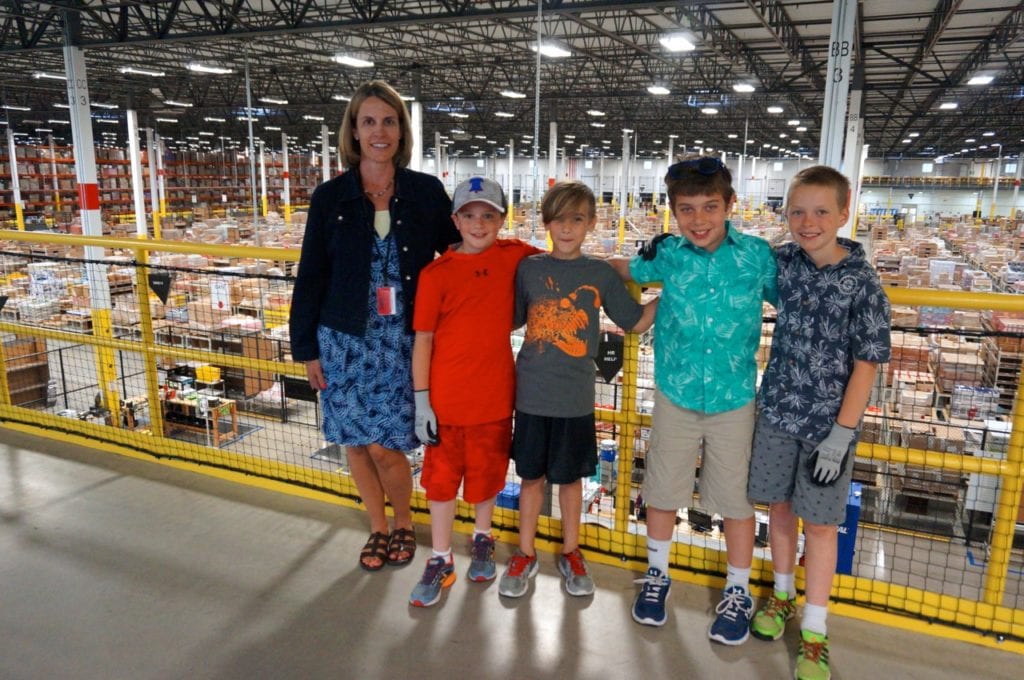
Norfeldt Elementary School QuEST teacher Kathy Hardesty poses with students Alexander Hyams, Charlie Sink, Evan Berey, and Britt Housum. Photo credit: Ronni Newton
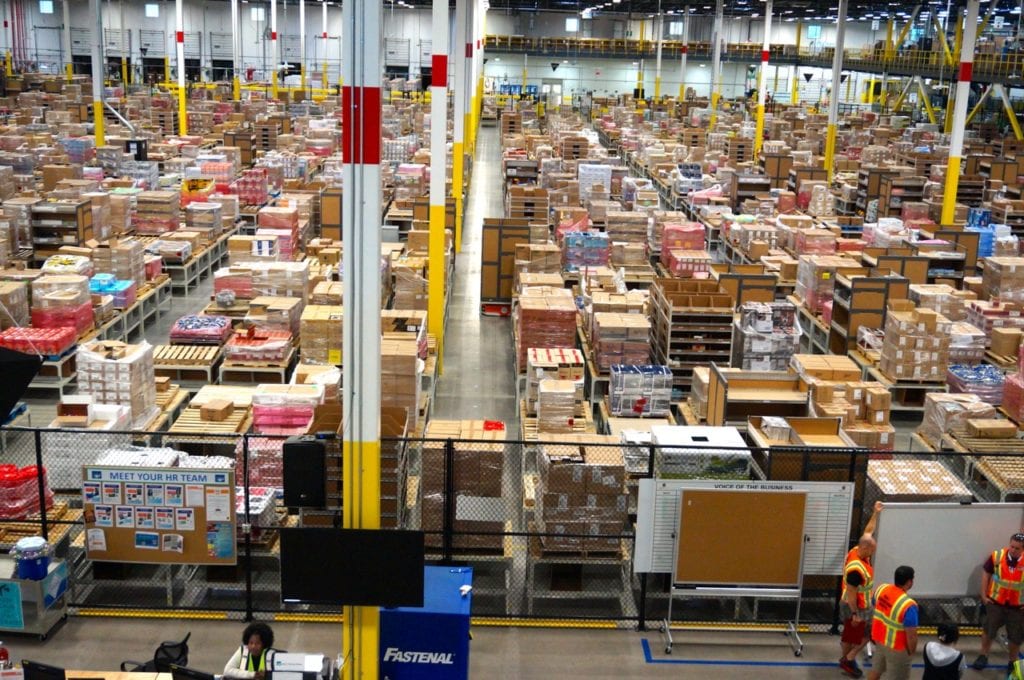
The vast floor of the Amazon Fulfillment Center in Windsor viewed from the learning center on the second floor. Photo credit: RonnI Newton
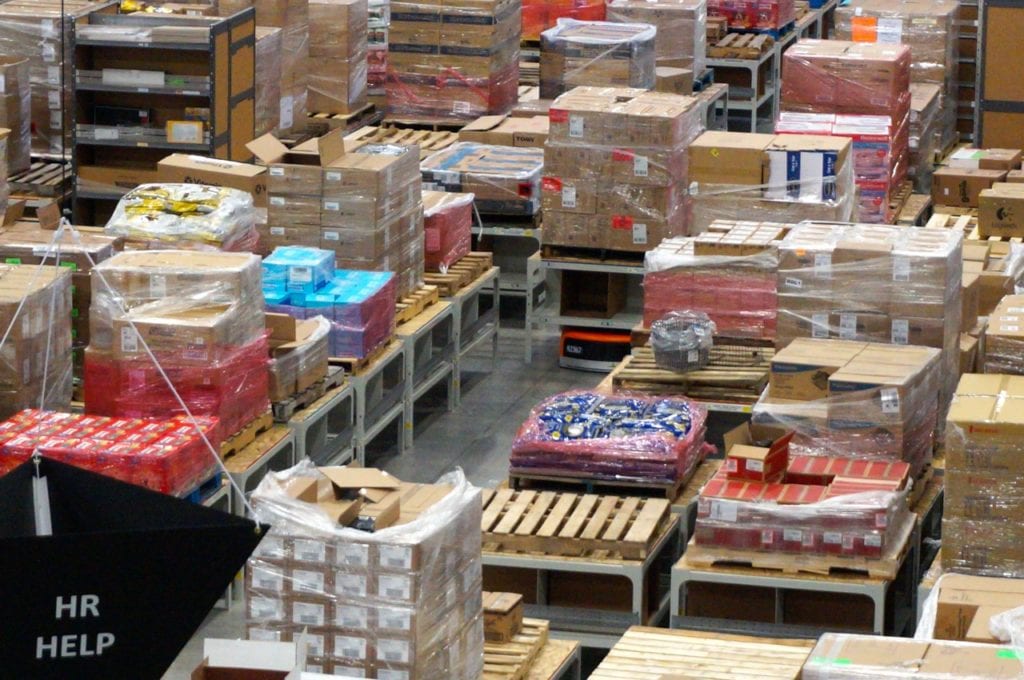
An orange robot (center) brings stowed items to a picker. Photo credit: Ronni Newton
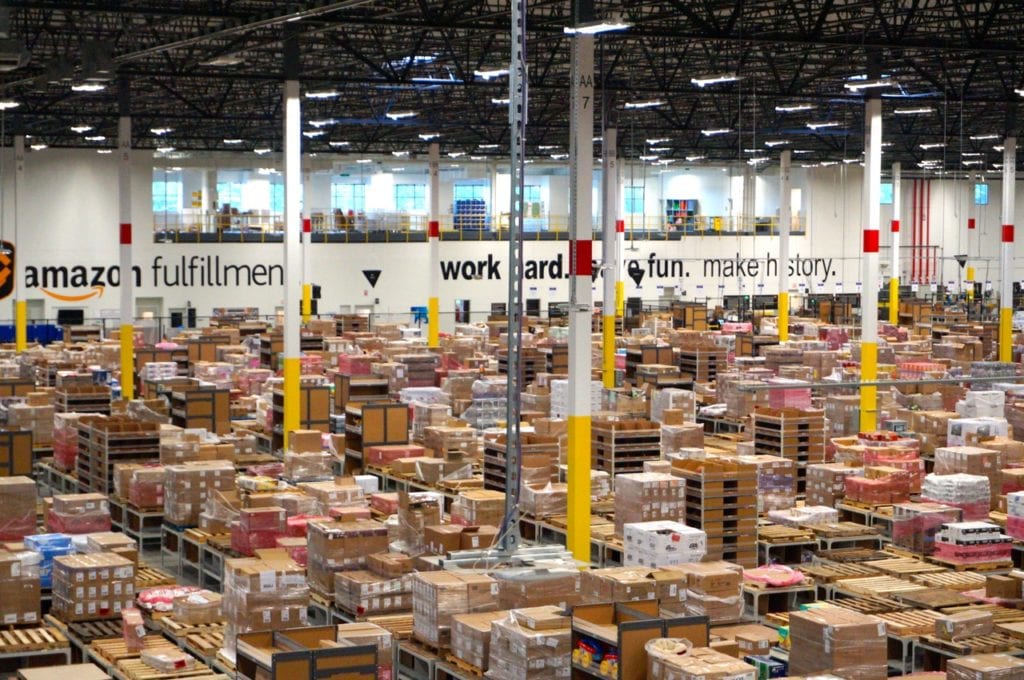
Floor of the Amazon Fulfillment Center in Windsor. The facility is more than 1 million square feet. Photo credit: Ronni Newton
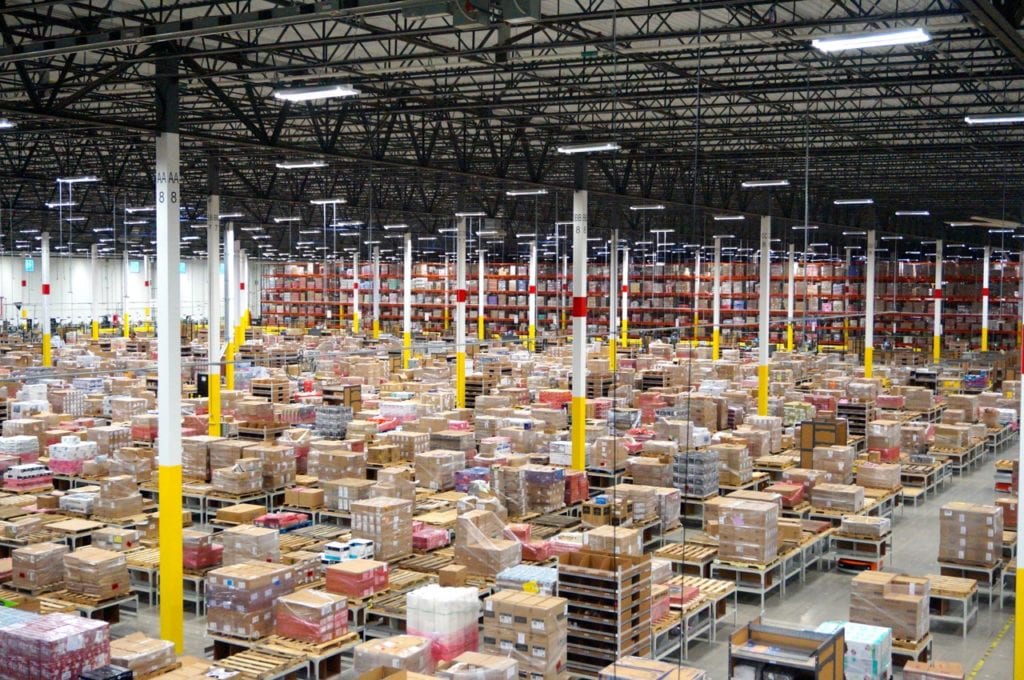
Floor of the Amazon Fulfillment Center in Windsor. Photo credit: Ronni Newton
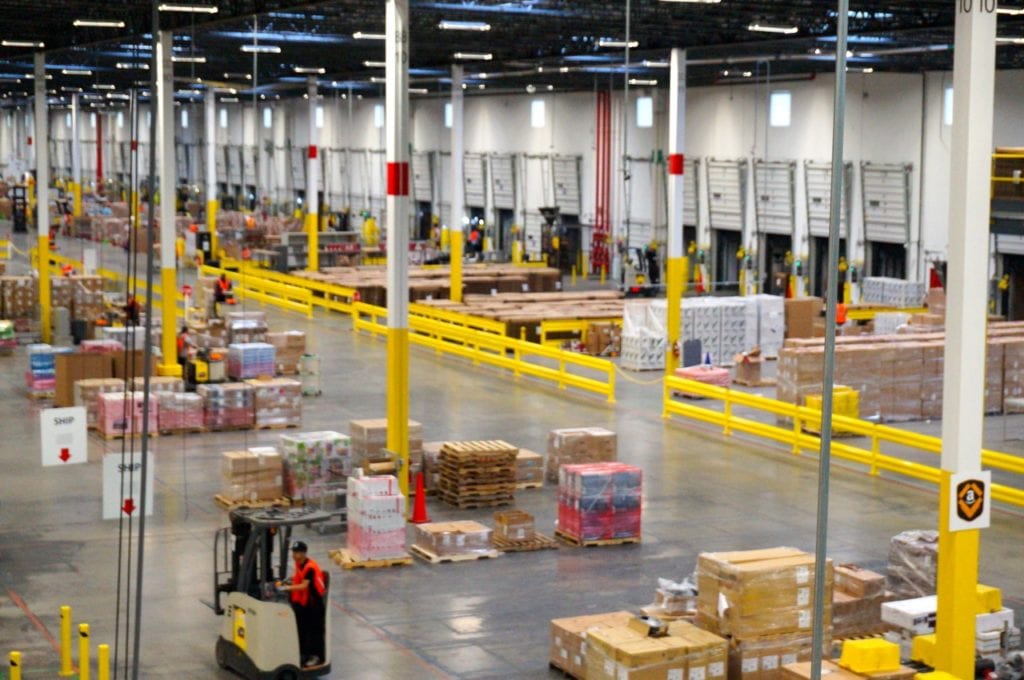
One side of the fulfillment center has a row of bays where items are delivered to the facility. Photo credit: Ronni Newton
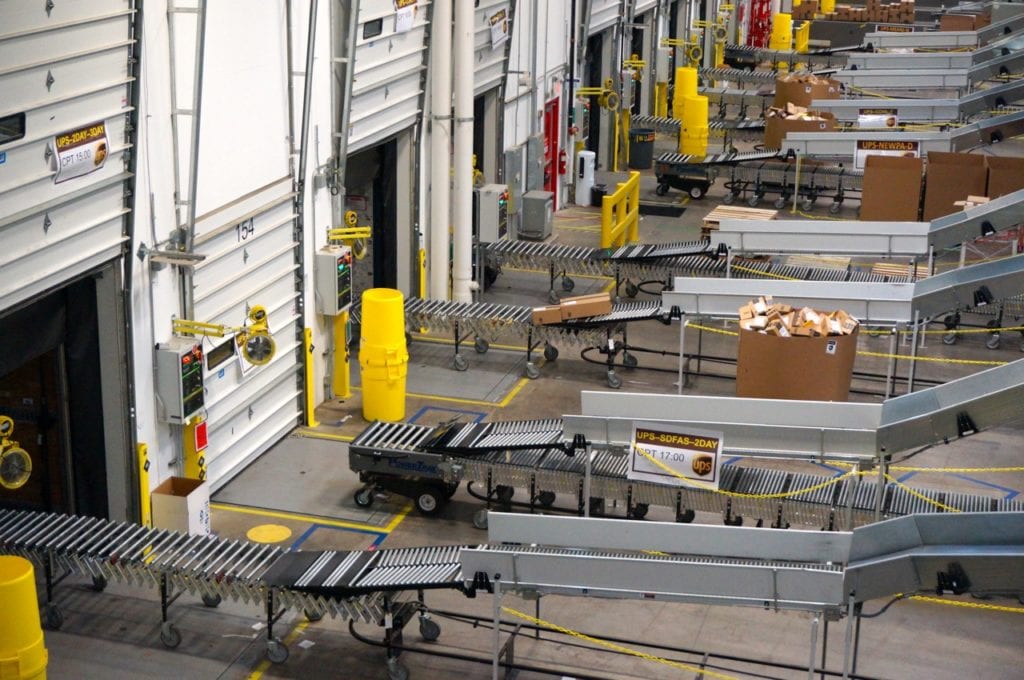
Packages ready for shipment travel down a conveyor belt directly into a waiting transit carrier’s truck. Photo credit: Ronni Newton
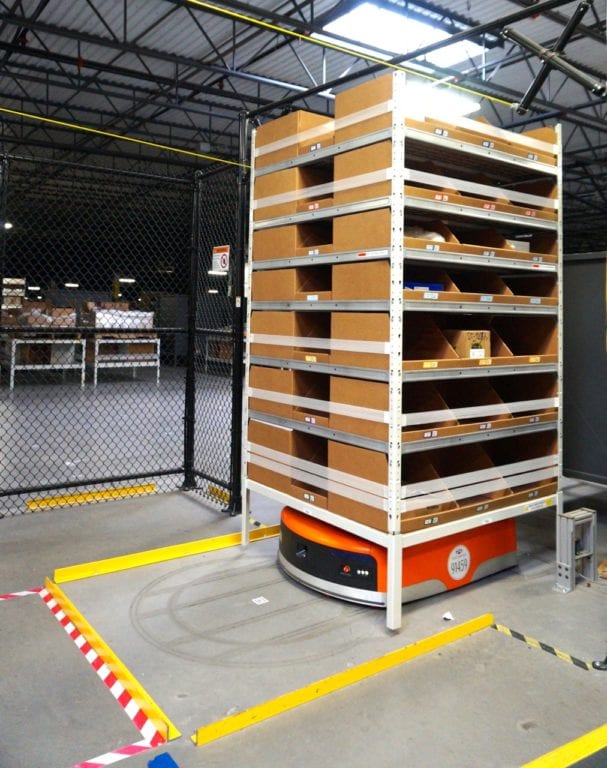
Orange robots transfer product around the floor of the fulfillment center. Photo credit: Ronni Newton
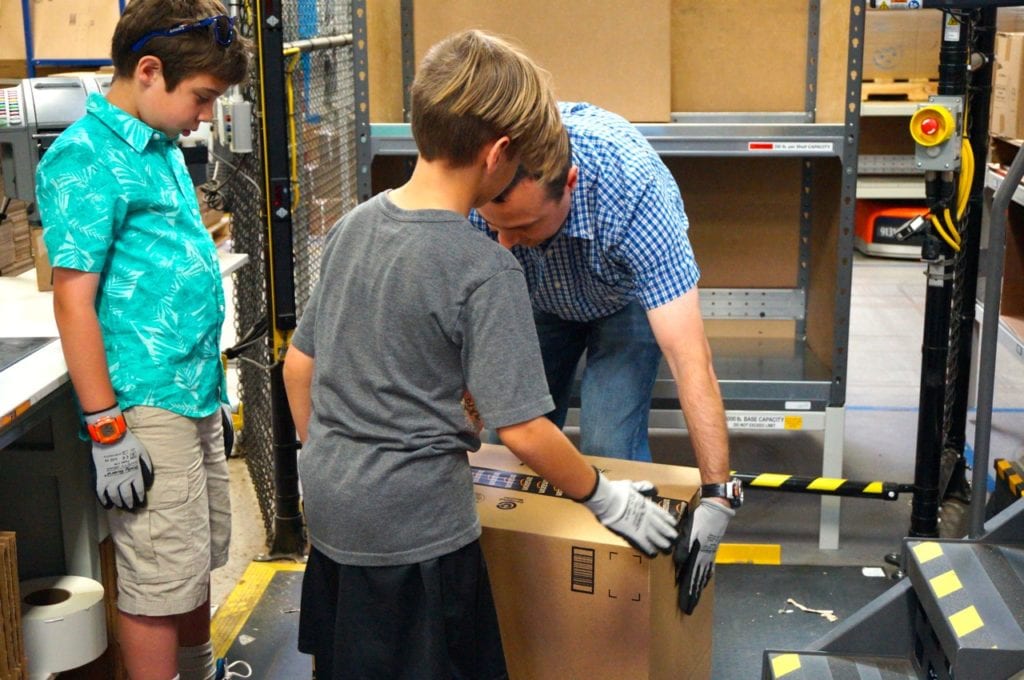
General Manager Jeff Laurendeau shows Evan Berey (left) and Charlie Sink how to pack a box. Photo credit: Ronni Newton
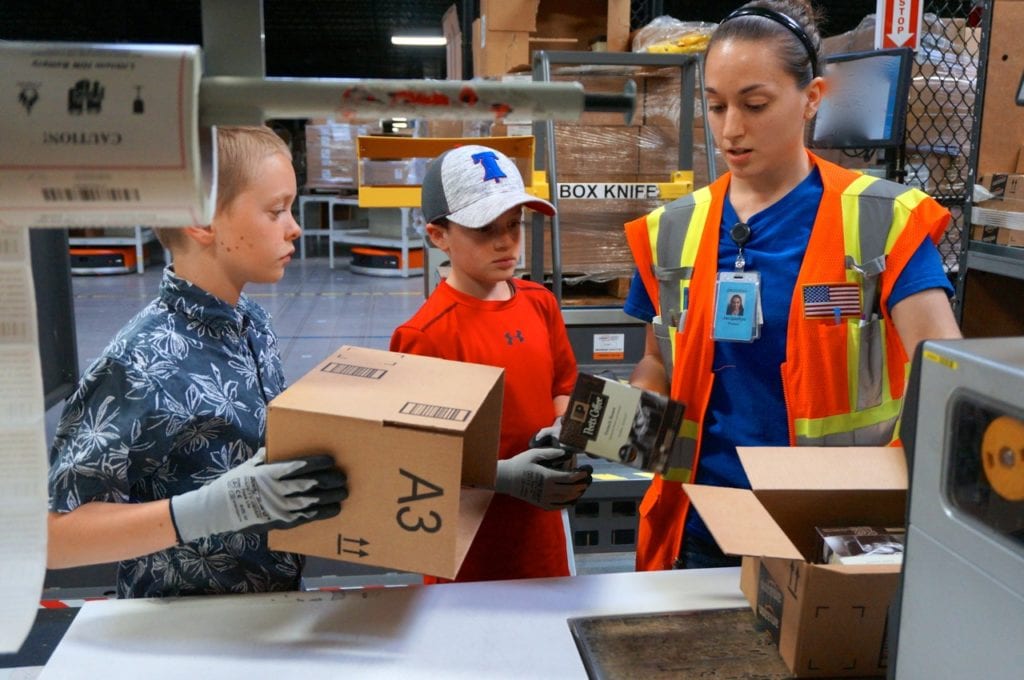
Britt Housum (left) and Alexander Hyams are instructed by Jackie of Amazon on how to place the product in the box. Photo credit: Ronni Newton
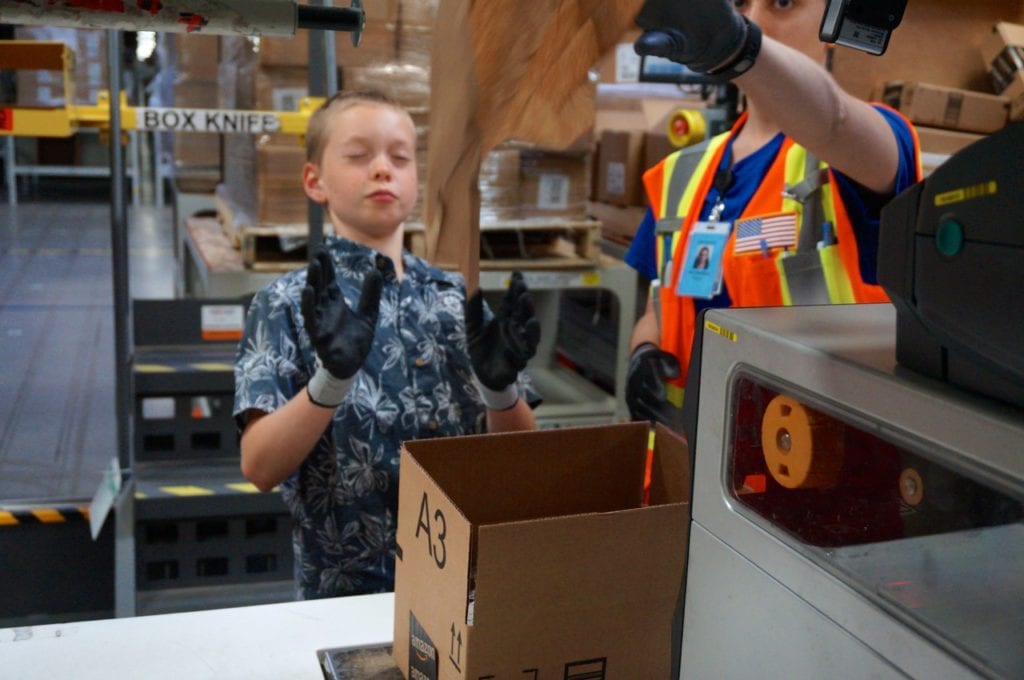
Britt Housum is startled that the packing paper is dispensed automatically at the push of a button. Photo credit: Ronni Newton
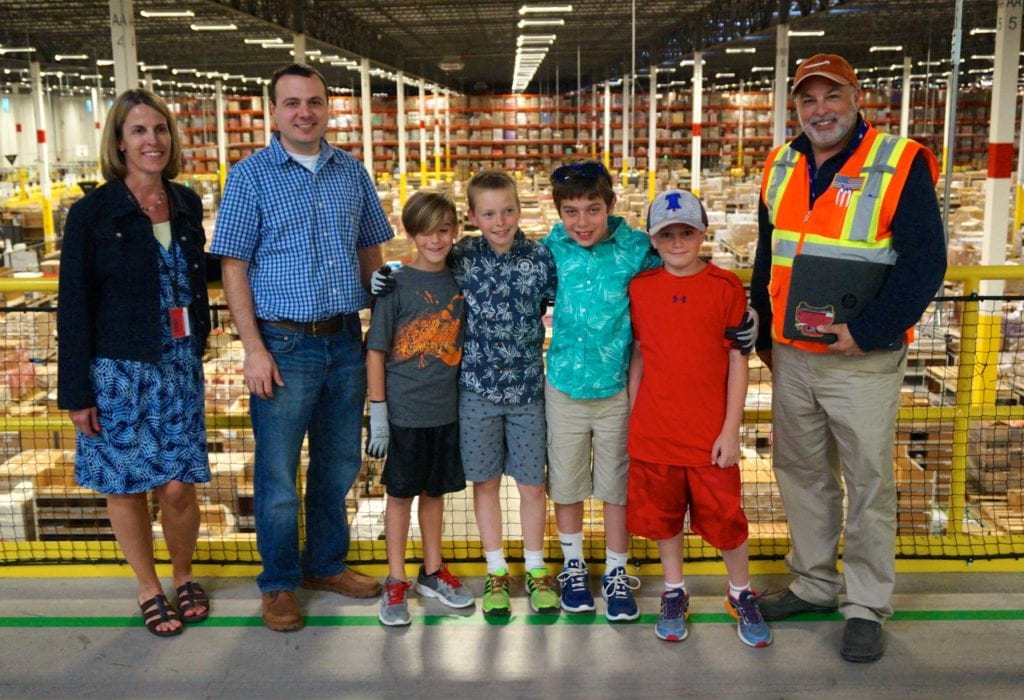
From left: QuEST teacher Kathy Hardesty, Amazon General Manager Jeff Laurendeau, Charlie Sink, Britt Housum, Evan Berey, Alexander Hyams, and John Parkos of Amazon after the tour. Photo credit: Ronni Newton
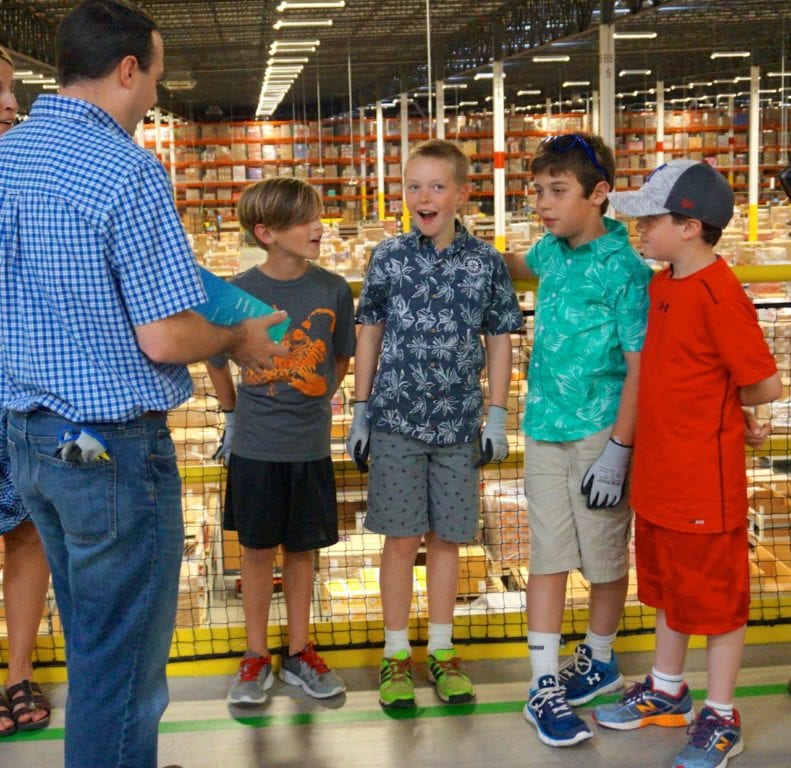
General Manager Jeff Laurendeau give Britt Housum (center) an Amazon Echo after the tour. Photo credit: Ronni Newton
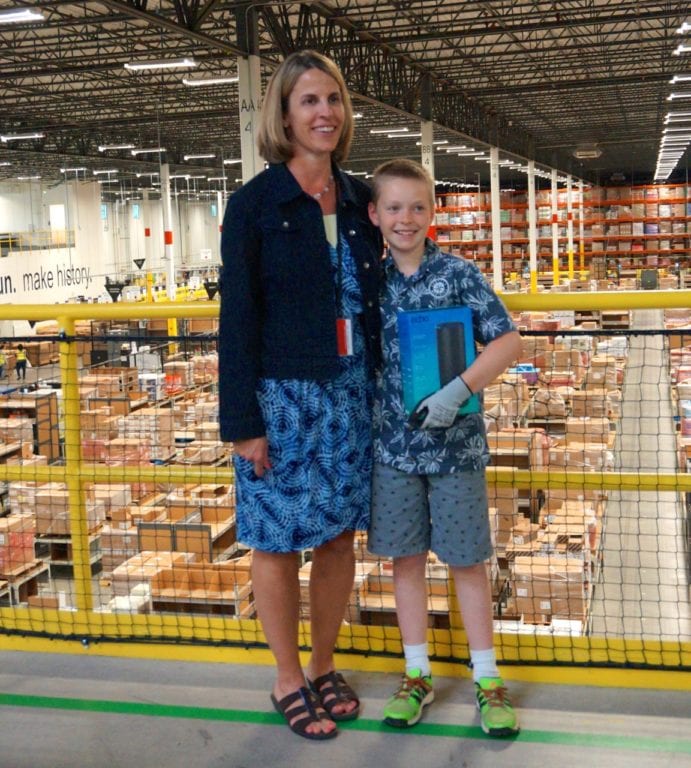
Britt Housum with QuEST teacher Kathy Hardesty after he received his Amazon Echo. Photo credit: Ronni Newton
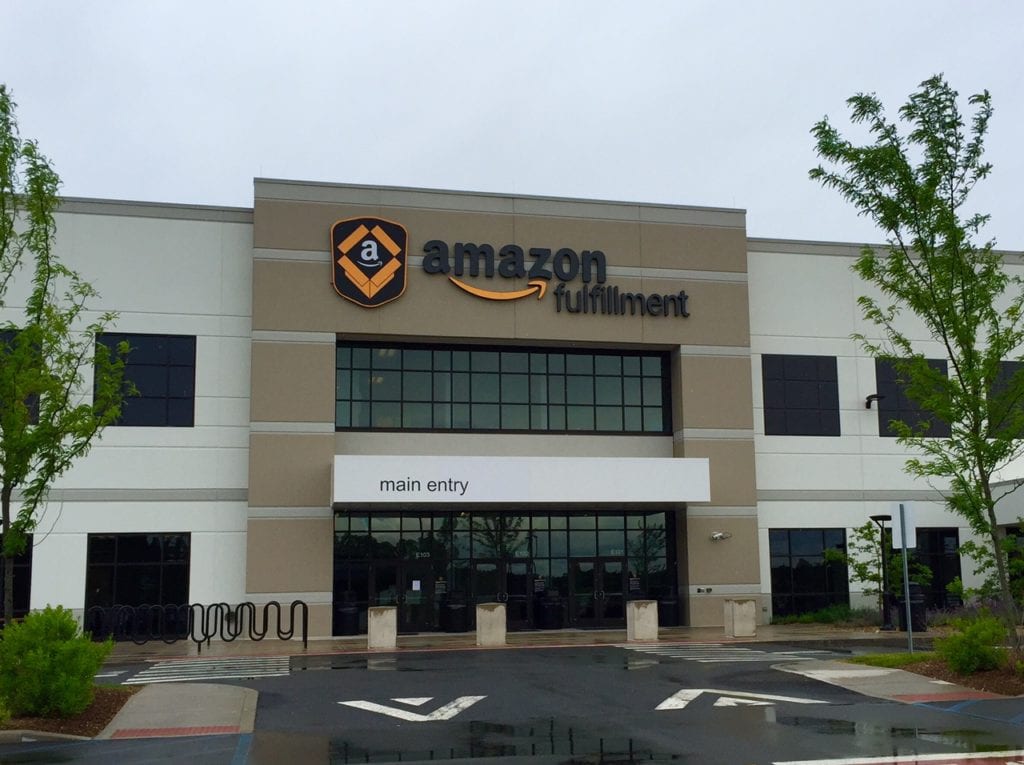
A West Hartford fourth grader, his dad, his QuEST teacher, and several classmates toured the Amazon Fulfillment Center in Windsor on Wednesday. Photo credit: Ronni Newton
Winning InvestWrite Essay by Britt Housum:
I’m writing about the stock Amazon. I know all about Amazon because I shop there all of the time. Amazon could help the community in lots of ways. I will tell you about Amazon’s investments, their employees, the delivery companies, and how Amazon affects them, and you will learn why my team chose Amazon to buy in our portfolio.
If Amazon’s stock goes up, the company will make investments. Some investments are opening new warehouses and improving their website. If Amazon improves their website, customers will be able to shop quickly and find items easily and get items to customers faster. Also, Amazon could build a warehouse to put items in. But that would take some time. First, Amazon will have to buy land to put the warehouse on. Then, they will have to hire architects, and builders to build the warehouse. Next, Amazon will have to hire employees to work in the warehouses.
An important part of Amazon is its employees. Employees are the workers in a company or business. If the company does not have any workers, it will fall apart, and the company will no longer exist. The company will have to hire more employees, and then more people will have jobs and money to help their families. Sometimes, a company will give its workers a raise or part of the stock in order for the workers not to quit and have Amazon spend money on hiring more employees. This will benefit the community because it will cause anyone looking for a job to find a job and work for money and help their families.
Another part of Amazon is the deliver companies. FedEx and UPS are two of the biggest delivery businesses. When Amazon’s stock goes up, it will not only affect its own business, but also will affect all the businesses that pitch in to helping the package get from Amazon to the person that ordered it (that means deliver the item to his or her house). Amazon will affect the delivery company. It will affect it because if Amazon goes up, UPS and FedEx will get more orders, and maybe have to hire more employees, and the stocks of all three businesses will go up and each company will have more money to work with. This means maybe more people who have no jobs might have options. These are a few reasons why Amazon can affect other businesses other than its own company.
Amazon is striving to be “Earth’s most customer-centric company.” That’s their mission statement. Amazon helps customers shop quickly and have a wide variety of items. Amazon is always trying to make their website better so customers will buy more often and that means they will get enough money to make warehouses. Amazon tries to be a time efficient company.
Since Amazon is such a large business with a lot of money it helps the community with not only providing customer service, but also donating money to the American Red Cross. On Amazon’s home page, there is a button that says donate, and the money goes to a place where something bad happened (for example, the bombing and shooting in Paris, France). Amazon also gave money one year to sponsor a local little league Baseball team. These are some ways that Amazon helps the community, and does not only provide customer service.
Amazon could not only be a long-term investment because it has lots of money and the investments it could make could benefit in making the company better. Like I said earlier, Amazon could make the website better or make a new warehouse where there are not very many warehouses. This is how Amazon could be a long-term investment.
Compared to some of the big stocks. Amazon is better. Every week, I watch it go up with my team and, on average, Amazon probably goes up 100 dollars a week. That is pretty good moneywise. Amazon has gotten more money than a lot of companies. In percentage, Amazon has made more money in three months than the huge stock Berkshire Hathaway.
The real reason we bought Amazon was because it was going up rapidly at the time, everyone on the team had experience with Amazon, and we thought Amazon was a cool company. I think Amazon is an AWESOME business!


